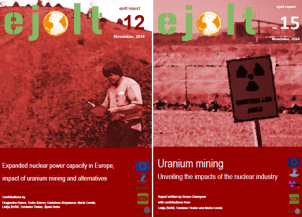
[BRUSSELS 19 November 2014] Two new reports expose the various myths used to hide the real impacts of uranium mining and to push for a nuclear renaissance in Europe. An international team of scientists and activists working for the global EJOLT project on environmental justice measured real-life impacts.
“Expanded nuclear power capacity in Europe, impact of uranium mining and alternatives” tackles the myths that nuclear energy is clean, reliable, cheap and climate friendly. In reality, nuclear energy capacity in Eastern Europe is characterized by hidden externalised costs, technical problems and covered-up dangers. At the same time, alternative options for energy production and measures for managing energy demand already exist. The report zooms in on Bulgaria and Slovenia, where the full range of issues with nuclear energy are exposed: from zombie mines to badly managed radioactive waste. Slovenia plans one new nuclear power plant and prolongs the life of another, while Bulgaria even plans for two new nuclear power plants. The report concludes that projected Bulgarian & Slovenian energy needs are deliberately exaggerated by competent authorities, while the nuclear power plant costs are grossly underestimated. This is despite the existence of an economically justifiable potential for renewable energy solutions, at lower cost per kWh.
The report can be downloaded here.
The policy briefing is here.
“Uranium mining. Unveiling the impacts of the nuclear industry” digs into the dirty business of uranium mining. It is hard to understand why most EU member states consider uranium as an indigenous energy source when nearly all of it is imported. The EU should improve the legislation and practices for limiting the environmental and health impacts of uranium mining. Bruno Chareyron (CRIIRAD): “Uranium mining is increasing the amount of radioactive substances in the biosphere and produces hundreds of millions tonnes of long lived radioactive waste. The companies have no solutions for the confinement of this waste and for the appropriate management of contaminated water flowing from the mine sites, even decades after mine closure”. The cost of remediation should be properly estimated and paid by the mining companies. Field studies done for this report reveal how zombie mines keep affecting the lives of thousands, even decades after the mines are closed.
The report can be downloaded here.
The policy briefing is here.
Notes to the Editor and contacts:
• More on the EJOLT project and its atlas with maps of nuclear and uranium mining conflicts
• Here’s also an EJOLT documentary on uranium mining in Namibia
• Visuals are available upon request
• On uranium mining: Bruno Chareyron, engineer in nuclear physics, head of the CRIIRAD laboratory (France): email hidden; JavaScript is required +33 6 27 27 50 37
• Slovenia case: Lidija Zivcic, environmental activist, senior expert at Focus email hidden; JavaScript is required
• Bulgaria case: Todor Slavov: environmental activist, senior expert at Za Zemiata email hidden; JavaScript is required + 359 887 505958


